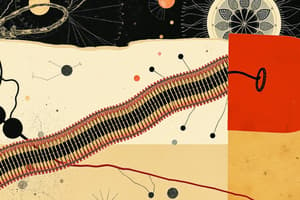Podcast
Questions and Answers
What is the branch of biology that deals with the study of microorganisms? change
What is the branch of biology that deals with the study of microorganisms? change
- Zoology
- Botany
- Microbiology (correct)
- Ecology
What is the process by which cells move molecules from an area of high concentration to an area of low concentration? change
What is the process by which cells move molecules from an area of high concentration to an area of low concentration? change
- Active transport
- Mitosis
- Meiosis
- Passive transport (correct)
What is the molecule that contains the genetic information necessary for the development and function of an organism?
What is the molecule that contains the genetic information necessary for the development and function of an organism?
- DNA (correct)
- Carbohydrate
- Lipid
- Protein
What is the term for the process by which one species gives rise to two or more descendant species?
What is the term for the process by which one species gives rise to two or more descendant species?
What is the term for the living organisms that produce their own food through photosynthesis?casgngam
What is the term for the living organisms that produce their own food through photosynthesis?casgngam
What is the process by which cells make a copy of their DNA before cell division?
What is the process by which cells make a copy of their DNA before cell division?
Study Notes
Branches of Biology
- Botany: study of plants
- Zoology: study of animals
- Microbiology: study of microorganisms
- Ecology: study of interactions between organisms and their environment
- Biochemistry: study of chemical processes in living organisms
- Molecular Biology: study of structure and function of biological molecules
- Genetics: study of heredity and variation
- Evolutionary Biology: study of evolution and diversity of life
Cell Biology
- Cellular structure: cell membrane, cytoplasm, nucleus, mitochondria, ribosomes
- Cell functions: metabolism, growth, reproduction, response to stimuli
- Cell division: mitosis, meiosis
- Cellular transport: passive transport (diffusion, osmosis), active transport
Genetics
- Mendel's Laws: segregation, independent assortment, dominance
- Inheritance patterns: autosomal, sex-linked, polygenic
- DNA structure: double helix, nucleotides (A, C, G, T)
- Gene expression: transcription, translation
Evolution
- Mechanisms: mutation, genetic drift, gene flow, natural selection
- Types of evolution: microevolution, macroevolution
- Fossil record: evidence for evolution
- Comparative anatomy and embryology: evidence for evolution
Ecosystems
- Biotic factors: living organisms (producers, consumers, decomposers)
- Abiotic factors: non-living components (light, temperature, water, soil)
- Energy flow: trophic levels, food chains, food webs
- Nutrient cycles: carbon, nitrogen, oxygen, water
Biological Molecules
- Carbohydrates: sugars, starches, cellulose
- Proteins: amino acids, structure, function
- Lipids: fats, oils, steroids
- Nucleic acids: DNA, RNA, structure, function
Studying That Suits You
Use AI to generate personalized quizzes and flashcards to suit your learning preferences.
Description
Explore the different fields of biology, including botany, zoology, microbiology, and more, as well as the basics of cell biology. Test your knowledge of the structures and functions of living organisms.




